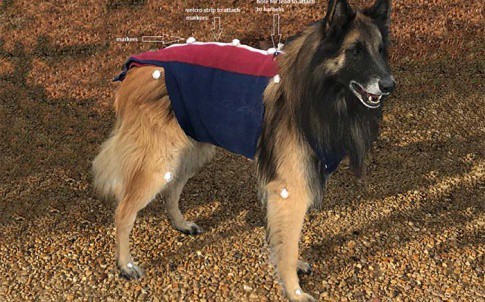
When Hartpury College and University Centre recently undertook a study to investigate canine gait analysis and force exerted on a lead in a collar and harness, HBM – a market leader in the field of test and measurement - was on hand to supply the necessary electronic strain gauges and software.
Considering the vast range of roles that dogs fulfil, it is important for dog owners to utilise the array of equipment available to help with these roles, such as collars and harnesses, both from a practical point of view and as part of a legal requirement.
The restraints, as required by law, provide the dog with the ability to move freely without pain whilst giving the handler control over it. However, it does not account for any unseen or unaccounted for force that the animal might be facing.
As part of its research to identify whether there is a significant difference in the gait of a dog when it is exercised using either a collar or a harness, and to analyse the degree of force exerted on the lead by the handler and the dog, Hartpury College specified the U9C strain gauge series from HBM to collect data on the amount of force experienced at the site of the dogs restraint.
The compact and cost-effective U9C series reliably measures tensile and compressive force where space is a constraint. Enabling dynamic and static measurement tasks to be solved, its high fundamental frequency also makes it suitable for very fast measurements. Manufactured in stainless steel and featuring a welded design, the U9C is a robust sensor for challenging applications.
By incorporating strain gauges onto the dogs harness and lead, Hartpury College was successfully able to achieve the desired measurements for both the dog and the handler. To make the design more robust, the transducer was sewn into a one meter lined fleece which enabled the gauge to be fixed to the D ring of the collar or harness. This gauge was then connected to a four-port express DAQ which was connected via USB to a laptop.
With the strain gauge and lead attached to the collar, the handlers walked and trotted dogs, and the process was then repeated with dogs wearing a harness instead
Catman data acquisition software (DAQ) also supplied by HBM, provided the data from both the handler and the dog in numeric data (Hz) pull from each of the trials. This enabled the raw data to be transferred to a spreadsheet and analysed with SPSS statistical analysis software.
The results collated from the study proved that using the particular types of collars and harnesses that the study used, there is no difference in gait when the dog is walking or trotting in a harness. However, it did show that the force exerted to the neck and throat via the collar is more localised, having the potential to cause damage or exacerbate existing injuries, whilst the force exerted when wearing the harness is distributed over a larger area, hence reducing the impact of the force. The data collected can be used by concerned pet owners to make a more educated decision.
For further information, please contact HBM on +44 (0) 1525 304980 or via email: info@uk.hbm.com or visit the HBM website at www.hbm.com










Water Sector Talent Exodus Could Cripple The Sector
Maybe if things are essential for the running of a country and we want to pay a fair price we should be running these utilities on a not for profit...